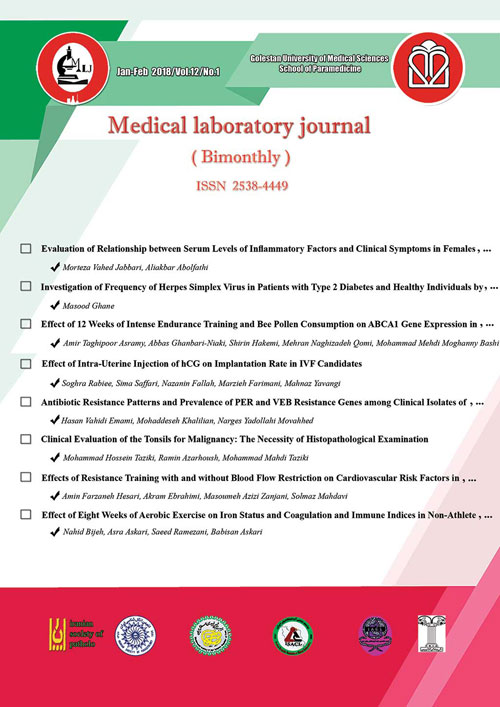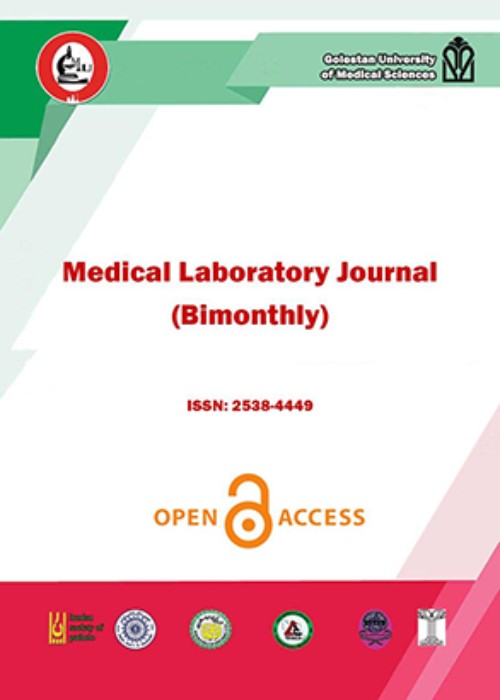فهرست مطالب

Medical Laboratory Journal
Volume:12 Issue: 1, Jan-Feb 2018
- تاریخ انتشار: 1396/12/25
- تعداد عناوین: 8
-
-
Pages 1-5Background And ObjectivesOsteoarthritis (OS) is the most common type of arthritis and joint disease, especially in women. Proinflammatory cytokines, biochemical factors, specially matrix metalloproteinases, and reactive oxygen species play important roles in joint destruction in this disease. Therefore, the present study aimed to evaluate level of inflammatory factors and its relationship with clinical symptoms of OS in female patients.
MethodsThe study was performed on female patients with knee OS, referring to healthcare centers of Tabriz University of Medical Sciences. After measuring the weight and height of patients, clinical symptoms such as severity of pain and physical performance were evaluated using the Knee Injury and Osteopaedic Outcome Score questionnaire. Serum levels of IL-1β, TNF-α, and hs-CRP in fasting blood samples were measured using ELISA kits and immunoturbidimetric assays.
ResultsThere was a significant association between level of IL-1β and score of pain. There was no significant relationship between the clinical symptoms and level of other inflammatory factors.
ConclusionThe results of the present study showed that the increase in inflammatory factors is correlated with severity of pain in OS patients.Keywords: Osteoarthritis Knee, Female, Inflammatory Markers -
Pages 6-10Background And ObjectivesPrevious studies have demonstrated the relationship between viral infections and risk of developing type 1 diabetes. The aim of this study was to investigate the frequency of Herpes simplex virus (HSV) in patients with type 2 diabetes and healthy control individuals using PCR and ELISA.
MethodsBlood samples were taken from 180 diabetic patients and 187 healthy controls referred to the Pasteur medical laboratory in Tonekabon, in 2016. Human beta-globin gene was used as internal control to ensure extraction accuracy. Specific primers were used for amplification of the UL30 gene. In addition, level of anti-HSV IgG antibody was measured using a commercial ELISA kit (Euroimmun, Germany).
ResultsDNA of HSV was found in the samples of 11 patients (6.1%) and five healthy controls (2.7%). In addition, anti-HSV IgG was found in the samples of 117 patients (65%) and 108 healthy controls (57.75%). There was a statistically significant relationship between frequency of anti-HSV IgG and diabetes.
ConclusionSimilar to previous studies, the present study demonstrated a relationship between frequency of HSV infection and type 2 diabetes. However, further studies should be performed to eliminate the effect of other risk factors to help clarify the exact role of viral infections in increasing the risk of diabetes.Keywords: Diabetes, Herpes Simplex Virus, ELISA, PCR -
Pages 11-16Background And ObjectivesThe aim of this study was to evaluate the effect of 12 weeks of intense endurance training and bee pollen consumption on ABCA1 gene expression in small intestine, liver and gastrocnemius muscle tissues of male rats.
MethodsIn this study, 24 male Wistar rats (aged 6-8 weeks and weighing 90-110 g) were randomly divided into four groups of saline-control (n=6), saline-training (n=6), bee pollen-control (n=6) and bee pollen-training (n=6). The training groups exercised on a treadmill for 12 weeks (30 m/min, 90 min/day, five days/week). The bee pollen groups were given bee pollen orally (500 mg/Kg) for 12 weeks. Data were analyzed using two-way ANOVA at significance level of 0.05.
ResultsABCA1 gene expression was highest in the liver, gastrocnemius muscle and small intestine, respectively. The findings also revealed that the intense endurance training caused a non-significant increase in ABCA1 gene expression in the small intestine and liver. However, the training caused a non-significant decrease in ABCA1 gene expression in the gastrocnemius muscle. In addition, consumption of bee pollen significantly increased ABCA1 gene expression in the small intestine and gastrocnemius muscle of male rats. However, the effect of bee pollen on the genes expression in the liver was not statistically significant.
ConclusionBased on our findings, it can be concluded that consumption of bee pollen has more beneficial effects on the ABCA1 gene expression and reverse cholesterol transport compared with the intense endurance training.Keywords: ABCA1 protein, Pollen, exercise -
Pages 17-20Background And ObjectivesHuman chorionic gonadotropin (hCG) is the embryonic hormone and one of the most important factors for implantation. The present study aimed to evaluate effect of intra-uterine injection of hCG before embryo transfer on the pregnancy outcome in IVF.
MethodsIn this study, 180 infertile patients were randomly allocated into an experiment and a control group. In the experiment group, before embryo transfer, 500 IU hCG were injected into the endometrium cavity in puncture stage. Equal amount of phosphate buffer (placebo) was injected to the subjects in the control group. Pregnancy test was done two weeks after the intervention. In case of positive results, ultrasound scan was done for detecting the gestational sac and numbers of sacs.
ResultsMean age of the patients was 30±3.41 years and 31±4.12 years in the experimental and control group, respectively. There was no statistically significant difference in the duration of infertility between the two groups (4.77±3.67 years vs. 4.87±3.74 years). Based on the hCG level, the pregnancy rate was 35.5% in both groups. However, based on ultrasound findings, the pregnancy rate was 35.5% and 28.8% in the experiment group and the control group, respectively (P=0.33). In addition, there was no significant difference in the pregnancy rates between different age groups.
ConclusionOur results indicate that the intra-uterine injection of β-hCG has no significant effect on the pregnancy rate in IVF.Keywords: Fertilization in Vitro, Chorionic Gonadotropin, Injections -
Pages 21-26Background And ObjectivesAcinetobacter species are responsible for a wide range of clinical complications in hospitalized patients. Antimicrobial treatment of clinical strains of Acinetobacter baumannii may be compromised due to multiple-drug resistance to b-lactams. Aim of this study was to determine antibiotic resistance patterns and frequency of PER and VEB genes in A. baumannii isolates from hospitalized patients.
MethodsIn this cross-sectional study, 100 clinical strains of A. baumannii were isolated from patients hospitalized in Qom (Iran) using specific culture media and biochemical tests. The disk diffusion method was performed to determine resistance to some antibiotics. Minimum inhibitory concentration (MIC) for cefepime and ceftazidime was evaluated. Identification of ESBL-producing strains and presence of the PER and VEB genes were determined by combined disk test and polymerase chain reaction, respectively.
ResultsThe isolates were highly resistant against cefixime, ceftriaxone and cefepime. Lowest level of resistance was against polymyxin B. In addition, 70% of the isolates were multi-drug resistant. MICConclusionMajority of A. baumannii isolates are highly resistant to the tested antibiotics. Due to presence of the PER and VEB genes in the isolated strains, there is the possibility of resistance spread to other bacteria. Therefore, it is recommended to modify the consumption pattern for antibiotics and pay more attention to standards of nosocomial infection control.Keywords: Acinetobacter baumannii, Drug resistance, PER, VEB -
Pages 27-30Background And ObjectivesTonsils are lymphoid tissues that can be affected in various diseases. In some cases, it is necessary to remove tonsils through surgery. Although the diseases are often diagnosed by history-taking and physical examination that proceeds with surgery, histologic examination is necessary for confirmed diagnosis of malignancy. Considering the low prevalence of tonsil cancer, this study was performed to clinically examine tonsils for malignancies and evaluate the necessity of histopathological examination.MethodsThis retrospective study was conducted on 2,232 patients (aged 2-80 years) who had undergone tonsillectomy for various reasons in the city of Gorgan from 2001 to 2012. Medical history was obtained and physical examination was carried out before surgery. All the obtained samples were sent to the laboratory for histopathological examination. Finally, the collected data was analyzed.ResultsOnly one case of lymphoma was found among the 2,232 patients investigated in this study. This 80-year-old woman with preoperative cervical lymphadenopathy and unilateral tonsillar enlargement went under tonsillectomy for confirmed diagnosis.ConclusionConsidering the high frequency of tonsillectomy and the low possibility of malignancy, and the fact that malignancy is often seen in individuals with obvious clinical presentations such as in our case, it is recommended to limit referral of specimens for histological examination to highly suspicious cases through more rational decision-making and summarization of other findings.Keywords: Hypertrophy, Malignancy, Lymphoma Pathology, Tonsillectomy
-
Pages 31-36Background And ObjectivesElevated blood lipid levels are correlated with risk of cardiovascular disease, especially in overweight individuals. The beneficial effect of strength training on lipid profile has been well documented. However, the effect of strength training with flow blood restriction has not been established. The purpose of this study was to compare the effect of eight weeks of strength training with and without blood flow restriction on some of the cardiovascular risk factors in overweight females.
MethodsIn this study, 28 overweight females aged 18 to 24 years were randomly assigned into three groups of blood flow restriction strength training (BFRT), traditional strength training (TRT) and control. Participants in the BFRT group performed eight weeks of strength training three sessions per week at 30% of 1-repetetion maximum, while participants in the TRT group performed the training at 65-80% of 1-repetetion maximum. Cardiovascular variables, systolic blood pressure and diastolic blood pressure were measured before and after the exercise training. Data was analyzed using descriptive statistics, paired t-test and one-way analysis of variance.
ResultsTriglyceride level decreased significantly in the BFRT (p=0.022) and TRT (p=0.038) groups compared with the control group. Moreover, there were no significant differences in the body mass, waist-to-hip ratio, body mass index, high-density lipoprotein, low-density lipoprotein, and cholesterol levels between the study groups (P≥0.05).
ConclusionOur findings suggest that the BFRT and TRT may not be suitable for preventing or even reversing the physiological changes induced by obesity.Keywords: Resistance Training, Lipids, lipoprotein, overweight -
Pages 37-43Background And ObjectivesThe aim of this study was to investigate the effect of eight weeks of aerobic exercise on serum iron, serum ferritin, platelet count, mean platelet volume, and some immunity indices in non-athlete females. In this study, 30 non-athlete females aged 30-45 years were randomly divided into an experimental and a control group. The experimental group was subjected to perform aerobic exercise at 60-70% of maximal heart rate for eight weeks, three sessions per week and one hour per session. Blood parameters were measured before the exercise program and after the completion of program by taking 2 ml blood samples from the venous vein of the participants in the sitting position. Finally, t-test was used to compare the pre-test and post-test means of each group and independent t-test was used to compare the two groups at significance of 0.05.
After eight weeks of aerobic exercise, there was a significant increase in mean platelet volume and a significant decrease in serum iron and ferritin levels in the experimental group (PConclusionWe recommend physical education instructors, athletes and non-athletes to consider iron supplementation during aerobic exercise, and modify appropriate training intensity based on the fitness and age of trainees to prevent risk of anemia.Keywords: Aerobic exercise, platelet, iron, ferritin, white blood cell


